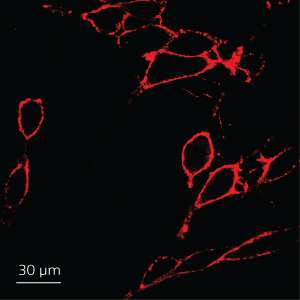Tiny conjugated polyelectrolyte-nanoparticle probes produced by ultrasonication prove superior to commercial products

James Bond liked his martini to be 'shaken not stirred', and now A*STAR researchers have found that shaking, rather than stirring, also produces better nanoparticles for bioimaging—with important implications for spying on cancer.
Fluorescent probes currently used for bioimaging (for example, cadmium selenide quantum dots) fluoresce brightly enough to show up on detectors but may be toxic and thus unsuitable for use in the body. Now, Bin Liu and her colleagues from the A*STAR Institute of Materials Research and Engineering have successfully fabricated nanoparticle probes that are biocompatible and also have a high specificity and photostability. Furthermore, these new probes have excellent performance in the far-red to near-infrared region of the electromagnetic spectrum, which is of particular interest for cancer imaging.
The team's method is elegant in its simplicity—it improves the optical properties of the probes by just varying the size and shape of the nanoparticles. "This allows us to circumvent complicated molecular design and synthesis processes," explains Liu. "It provides a facile but efficient method for developing highly far-red–near-infrared fluorescent probes."
The researchers produced the nanoparticles in water by two methods—stirring and ultrasonication (that is, 'shaking' at very high frequencies). Ultrasonication yielded nanoparticles with average sizes of 4 nanometers, which is considerably smaller than their stirred counterparts. These nanoparticles were also much brighter, having a quantum yield of 26 per cent in water—more than five times brighter than the nanoparticles produced by stirring.
Liu explains that ultrasonication produces polymer chains that are closer together, resulting in "compact structures that can effectively prevent water invasion and thus suppress quenching, yielding enhanced fluorescence."
The researchers then tested the behavior of the nanoparticles produced by sonication in a biological setting to determine whether they would be effective probes for a specific biological target. They chose streptavidin, a protein that has a high affinity for epithelial cell adhesion molecule (EpCAM) ― a common biomarker for various cancers. After conjugating streptavidin to the surfaces of the nanoparticles, the researchers investigated the nanoparticles' effectiveness as an extracellular probe for EpCAM by employing MCF-7 breast cancer cells as a model cell line (see image). The nanoparticles exhibited an excellent photostability and a much higher fluorescence than a commercially available probe (Cy3-SA).
Liu notes that by switching streptavidin with another protein the same nanoparticles could be used to target other biomarkers. "This will lead to a new generation of fluorescent probes for image-guided therapy," she says.
More information: Liu, J., Feng, G., Liu, R., Tomczak, T., Ma, L. et al. "Bright quantum-dot-sized single-chain conjugated polyelectrolyte nanoparticles: Synthesis, characterization and application for specific extracellular labeling and imaging." Small 10, 3110–3118 (2014). dx.doi.org/10.1002/smll.201303505
Journal information: Small




















